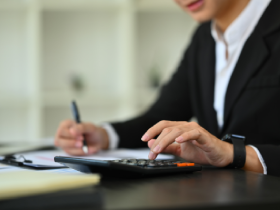Most businesses need to spend money in order to start making money, with costs that might include anything from paying rent to buying in stock.
Tracking these costs is a crucial (albeit sometimes complicated) part of running and growing your business – not least because it enables you to take advantage of tax relief on allowable expenses, so you only have to pay tax on your actual profits.
You might be wondering the best way to go about calculating and managing your business expenses and the good news is that you’ve got options. The one we put under the spotlight here is the flat rate method.
Flat rate expenses explained
Flat rate expenses are designed to streamline the process of submitting tax relief claims for a set amount of business-related costs each year.
This method provides an alternative to having to calculate and track actual costs for every purchase or transaction. It also makes tax reporting and claiming tax relief far easier.
(You have up to four years to apply for flat rate tax relief, so if there are any periods you’ve missed, go back and make sure you’re claiming all the relief you’re entitled to!)
Note: Simplified expenses can only be used by sole traders or business partnerships that don’t have any limited companies as partners.
Are flat rate expenses and simplified expenses the same thing?
Before we look at the benefits of using the flat rate method to calculate and manage business expenses, it’s important to note that flat rate expenses and simplified expenses are different names for what are essentially the same thing.
The name ‘simplified expenses’ was given to this method because it is, quite literally, a simpler way of doing things thanks to the easy flat rates that are applied.
What are the benefits of using simplified expenses if I’m self-employed?
Using simplified expenses to work out your claim for tax relief does have some advantages:
- Less time and effort spent calculating and recording expenses means more time to focus on growing your business and striking a healthy work-life balance
- When the process is quicker and easier, there’s less chance of making mistakes – which is good news for the accuracy of your tax return!
Although there are many benefits, it’s important to consider whether claiming expenses using the flat rate method is the most financially efficient option for you.
It might be quicker and easier, but if your actual costs are considerably higher, then applying this method could mean you lose out on tax relief you’re entitled to.
The government has a handy calculator tool that can help you check whether or not flat rate (simplified) expenses will help save your business money.
When to use flat rate expenses
The time to use flat rate (or simplified) expenses is when calculating actual costs would be more effort than necessary. You don’t have to keep detailed records of every expense when you use this method so it’s far quicker and easier.
How do I work out expenses using the flat rate?
There are three specific categories of business costs that flat rates can be used for if you’re self-employed:
Living at a place of work
If your business premises are also where you live, you can claim flat rate expenses based on how many people live at the property. The current rates are set at:
- 1 person: £350 per month
- 2 people: £500
- 3+ people: £650
Driving a business vehicle
If you have a vehicle that you use for business purposes (for example, you’re a mobile hairdresser who travels to meet clients), you can claim flat rate expenses on the miles you travel each year for work.
The flat rates for driving a business vehicle are currently:
- Cars and vans: 45p per mile for the first 10,000 miles you travel in the year, and then 25p per mile after that
- Motorcycles: 24p per mile
If you employ staff, they may also be able to claim these flat rate expenses, providing they meet the necessary criteria.
Working from home
Flat rate expenses are particularly handy for those who work from home for more than 25 hours a month. You can simply apply one of HMRC’s flat rates according to how much you use your home for work purposes or business-related activity.
The current flat rates for working from home are:
- 25-50 hours per month: claim £10 expenses per month
- 51-100 hours per month: claim £18 expenses per month
- 101+ hours per month: claim £26 expenses per month
It is important to note, however, that flat rates don’t cover internet or telephone costs when calculating expenses when working from home.
Other ways to calculate expenses
When you don’t want to use a blanket flat rate method, or when you can’t, you can use what’s called the ‘costs method’, or ‘actual costs’.
Costs method
This is far more granular than flat rates as it requires you to calculate and record your actual costs and the expenses specifically related to your business.
When working from home, for instance, it means you have to separate your personal and business costs to figure out which portion of your expenses relate directly to work use.
For example, if you have a property with three bedrooms and one of those is your home office, a third of your property is used for business-related activity. So, if your electricity bill for the month comes to £600, you can only claim £200 (a third) as an allowable expense.
That said, it may be the case that using actual costs allows you to claim the most tax relief and operate your business in the most tax-efficient way.
We’d always recommend asking an accountant to help you figure out what the recommended course of action is for you.
Managing expenses can be tricky, especially if you’re new to running your own business. Check out our accounting support hub for more help, or to ask a tax question!









Leave a Reply